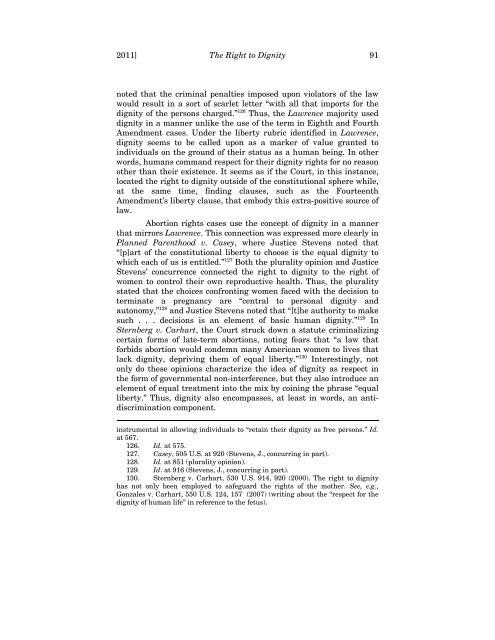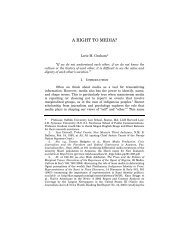The Right to Dignity Rex D. Glensy - Columbia Law School
The Right to Dignity Rex D. Glensy - Columbia Law School
The Right to Dignity Rex D. Glensy - Columbia Law School
Create successful ePaper yourself
Turn your PDF publications into a flip-book with our unique Google optimized e-Paper software.
2011] <strong>The</strong> <strong>Right</strong> <strong>to</strong> <strong>Dignity</strong> 91<br />
noted that the criminal penalties imposed upon viola<strong>to</strong>rs of the law<br />
would result in a sort of scarlet letter “with all that imports for the<br />
dignity of the persons charged.” 126 Thus, the <strong>Law</strong>rence majority used<br />
dignity in a manner unlike the use of the term in Eighth and Fourth<br />
Amendment cases. Under the liberty rubric identified in <strong>Law</strong>rence,<br />
dignity seems <strong>to</strong> be called upon as a marker of value granted <strong>to</strong><br />
individuals on the ground of their status as a human being. In other<br />
words, humans command respect for their dignity rights for no reason<br />
other than their existence. It seems as if the Court, in this instance,<br />
located the right <strong>to</strong> dignity outside of the constitutional sphere while,<br />
at the same time, finding clauses, such as the Fourteenth<br />
Amendment’s liberty clause, that embody this extrapositive source of<br />
law.<br />
Abortion rights cases use the concept of dignity in a manner<br />
that mirrors <strong>Law</strong>rence. This connection was expressed more clearly in<br />
Planned Parenthood v. Casey, where Justice Stevens noted that<br />
“[p]art of the constitutional liberty <strong>to</strong> choose is the equal dignity <strong>to</strong><br />
which each of us is entitled.” 127 Both the plurality opinion and Justice<br />
Stevens’ concurrence connected the right <strong>to</strong> dignity <strong>to</strong> the right of<br />
women <strong>to</strong> control their own reproductive health. Thus, the plurality<br />
stated that the choices confronting women faced with the decision <strong>to</strong><br />
terminate a pregnancy are “central <strong>to</strong> personal dignity and<br />
au<strong>to</strong>nomy,” 128 and Justice Stevens noted that “[t]he authority <strong>to</strong> make<br />
such . . . decisions is an element of basic human dignity.” 129 In<br />
Sternberg v. Carhart, the Court struck down a statute criminalizing<br />
certain forms of lateterm abortions, noting fears that “a law that<br />
forbids abortion would condemn many American women <strong>to</strong> lives that<br />
lack dignity, depriving them of equal liberty.” 130 Interestingly, not<br />
only do these opinions characterize the idea of dignity as respect in<br />
the form of governmental noninterference, but they also introduce an<br />
element of equal treatment in<strong>to</strong> the mix by coining the phrase “equal<br />
liberty.” Thus, dignity also encompasses, at least in words, an anti<br />
discrimination component.<br />
instrumental in allowing individuals <strong>to</strong> “retain their dignity as free persons.” Id.<br />
at 567.<br />
126. Id. at 575.<br />
127. Casey, 505 U.S. at 920 (Stevens, J., concurring in part).<br />
128. Id. at 851 (plurality opinion).<br />
129. Id. at 916 (Stevens, J., concurring in part).<br />
130. Sternberg v. Carhart, 530 U.S. 914, 920 (2000). <strong>The</strong> right <strong>to</strong> dignity<br />
has not only been employed <strong>to</strong> safeguard the rights of the mother. See, e.g.,<br />
Gonzales v. Carhart, 550 U.S. 124, 157 (2007) (writing about the “respect for the<br />
dignity of human life” in reference <strong>to</strong> the fetus).















